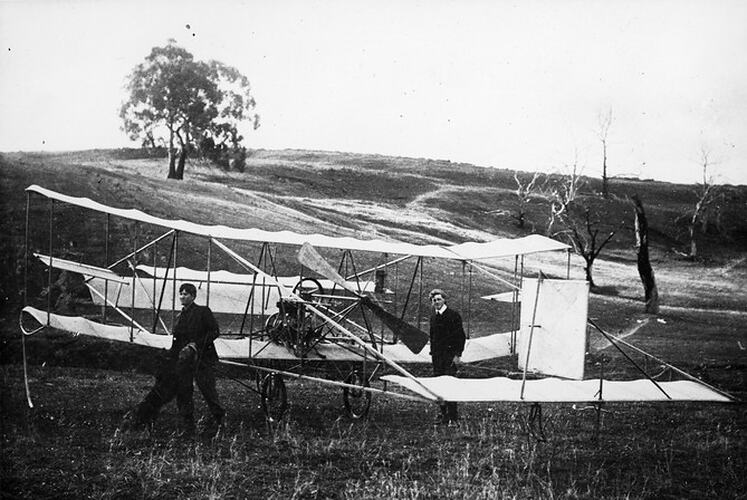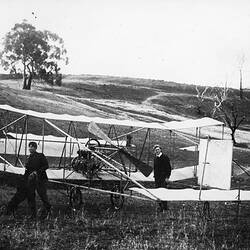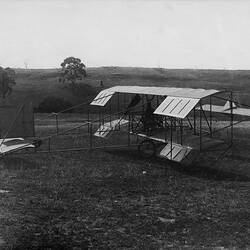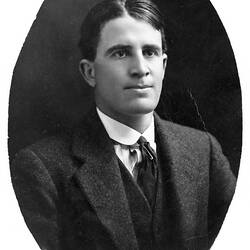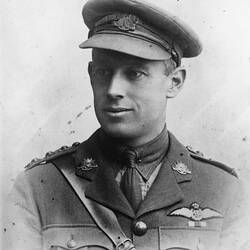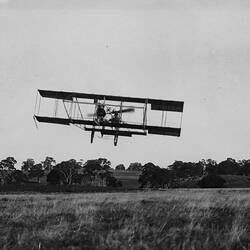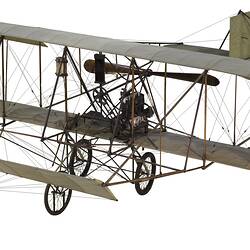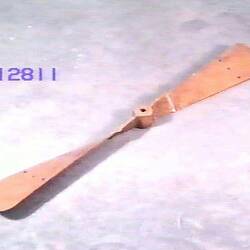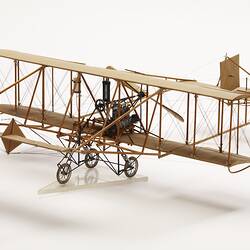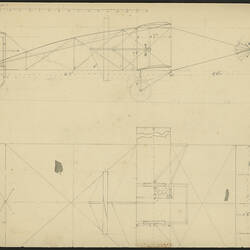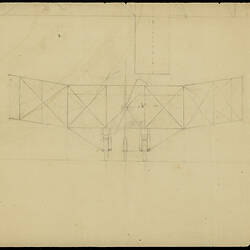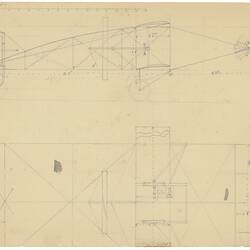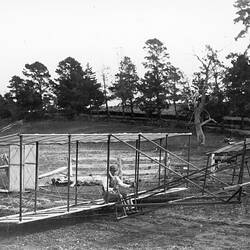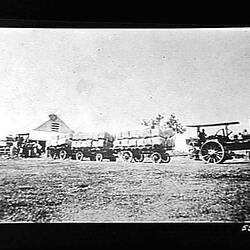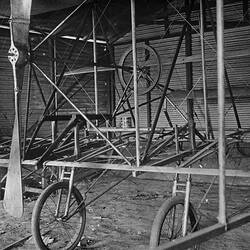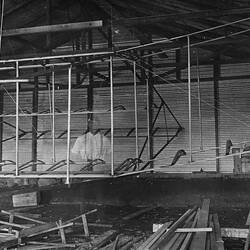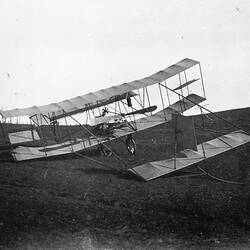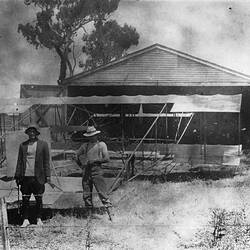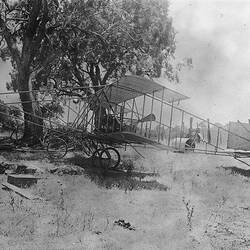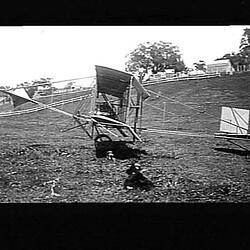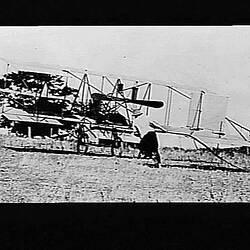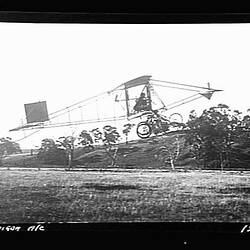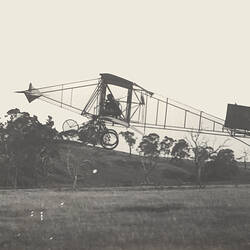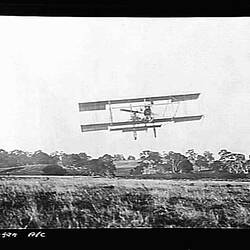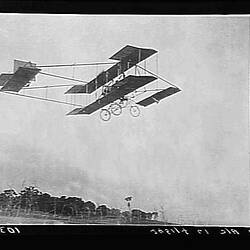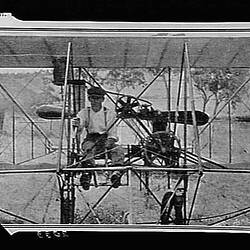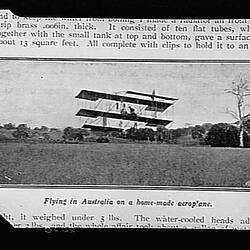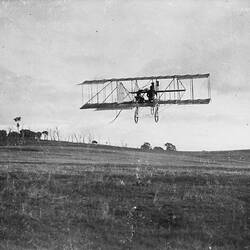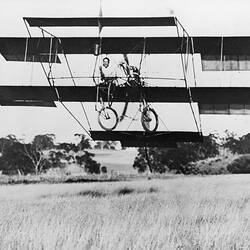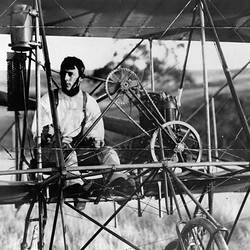Shortly after receiving a postcard from a friend in Britain acclaiming the success of the Wright Brothers first public flights in Europe in late 1908, John Duigan began the first steps towards building his own aircraft by constructing a crude box kite at his father's pastoral property 'Spring Plains', near Mia Mia in central Victoria. Taking only a day to build, with 'no balancing arrangements of any kind', the kite was a disappointment failing to provide lift and soon ended up on a bonfire. With help from his brother Reg, John then set about building a glider based on a half scale version of the Wright flyer with little information other than the postcard picture to go by. In early 1909 the glider was 'flown' by both men tethered to a strand of fencing wire in a strong wind. It produced good lift but was difficult to control, proving very sensitive in pitch moving up and down alarmingly.
Making use of his experience with the glider and having obtained a copy of Sir Hiram Maxim's book 'Artificial & Natural Flight', Duigan began work on a powered aeroplane based largely on a drawing of the Farman-type pusher-engine biplane illustrated in Maxim's book. He also subscribed to the British aviation journals 'The Aero' and 'Flight', which provided additional information on the work of others overseas. A shed for the new biplane was built at the top of a hill near the 'Spring Plains' homestead by the station carpenter. Duigan was not otherwise employed at this time and could devote himself full-time to the project, assisted wherever possible by Reg, who was managing the property. The framework was made of seasoned mountain ash timber with red pine wing ribs. Duigan incorporated several innovative features such as mid-wing ailerons for lateral control and pneumatic shock absorbers for the two main wheels of the undercarriage. Pitch control was initially achieved by a fixed foreplane and moving front elevator, with a foot operated rudder fitted for yaw control. A four-cylinder in-line air-cooled 20-25 horsepower engine was built in Melbourne to Duigan's specification by J.E. Tilley who ran an engineering business at 63 Little Latrobe Street. Tilley had previously been employed at the Working Men's College as an engineering assistant.
Test Flights
'Spring Plains' was a hilly property and the only level ground for flying was a creek flat below the homestead, where there was a narrow roughly ploughed paddock about 1,200 metres in length and just 90 metres wide, with a dog-leg bend in the middle. In mid 1910 the biplane was ready for test runs where it hopped or 'tip-toed' across the ground according to Reg. On 16 July 1910 a short flight of about 20 feet (6 metres) was achieved, but John was not satisfied that this was a controlled flight. Despite John's reticence, this date is now celebrated as the first flight of an Australian-built aeroplane. Lack of engine power and thrust from the propeller were addressed by changing the drive belt to a chain drive and fitting a new larger propeller.
Following a minor accident in which a wheel was buckled and a wing-tip damaged, more substantial changes were made to the airframe to improve flight control by replacing the outer dihedral wing sections with straight wing extensions, removing the fixed foreplane, shortening the forward foreplane frames, and fitting ailerons to upper and lower wings and a tab type elevator to the tailplane behind the rudder. These changes led to progressively longer hops until on 7 October 1910, a successful flight of about 196 yards (180 metres) was achieved, witnessed by six people, which Duigan regarded as his first fully controlled flight.
Public Acclaim
News of Duigan's successful flights was first published in Melbourne newspapers The Leader, on 1 October 1910, and The Argus, on 8 October 1910, followed by other interstate newspapers.
After unsuccessfully attempting to have his biplane considered for the £5,000 Commonwealth (Australian Government) prize for a military flying machine, which had closed in June 1910, Duigan continued to make further improvements and test flights. To improve engine power in warm weather he ordered a new set of jacketed cylinders and painstakingly soldered over 500 joints to make a homemade radiator, enabling him to convert the engine to water-cooling. In a last attempt to boast the power output he bored out the cylinders by 8 mm and fitted larger pistons. Finally confident that he had a reliable machine, Duigan embarked on a series of public demonstration flights.
On 25 January 1911, John performed a demonstration flight at Spring Plains for the sporting editor and a photographer from The Argus and was rewarded with an extensive illustrated article in the newspaper the following Saturday. In April, he exhibited the biplane at the Bendigo Easter Fair, where a short ground run was made on the showground arena. On 3 May 1911, Duigan flew the biplane at the Bendigo racecourse before a crowd of 1,000 paying spectators for a charity fund-raiser. He made three flights at the racecourse of up to three-quarters of a mile (1,200 metres) including his only circling flight, having previously only able to make straight flights at 'Spring Plains' due to surrounding fences, trees and hills.
On 30 May 1911 a final demonstration was made back at 'Spring Plains' for representatives of the Department of Defence and the Aerial League of Australia, with both John and Reg making flights. Having achieved all he could with the design, John had the machine wheeled back into the shed where it would be left quietly gathering dust for the next nine years, and in June 1911 left for England to further pursue his aviation interests.
References:
The Argus, 8 Oct 1910, p.18, 'Australian Biplane', http://nla.gov.au/nla.news-article10467505
The Argus, 28 Jan 1911, p.8, 'Australian Aviator', http://nla.gov.au/nla.news-article10874795
Duigan, J.R.,'Aviation in Australia and Pioneers' in Flight, 6 Apr 1912.
Crotty, David, A flying life: John Duigan and the first Australian aeroplane, Museum Victoria, Melbourne, 2010.
Kendall, F.J., 'John Robertsoon Duigan, a pioneer aviator in Australia', The Victorian Historical Magazine, No.45, 1974.
Maxim, Sir H., Artificial and Natural Flight, Whittaker & Co., London, 1908.
Meggs, K., Australian-Built Aircraft & the Industry, vol.1, book 1, 1884-1939, Four Finger Publishing, Seymour, Victoria, 2009.
Parnell, N. & Bouighton, T., Flypast: A Record of Australian Aviation, Australian Government Publishing Service, Canberra, 1988.
Duigan, John Robertson (1882 - 1951), Australian Dictionary of Biography Online Edition, http://adbonline.anu.edu.au/biogs/A080384b.htm.
John Robertson Duigan & Reginald Charles Duigan, http://www.ctie.monash.edu.au/hargrave/duigan_bio.html.
More Information
-
Keywords
-
Localities
-
Authors
-
Article types
